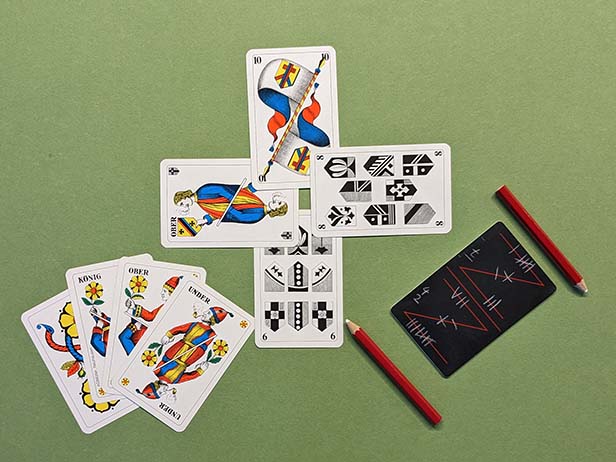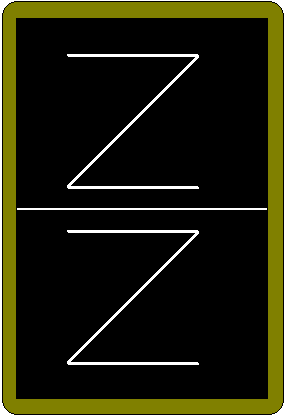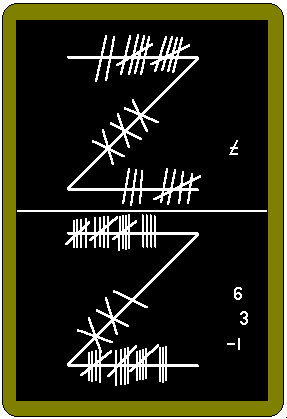Schieber Jass

Four-player partnership version of the Swiss national card game. It is a point-trick game with some extra points for declarations, in which you may play a trump to any trick even if you have a card of the suit led.
Class: Jass group
Related games: Sidi Barrani (Jass), Coiffeur-Schieber Jass
Region: Switzerland, Austria
- Introduction
- The Slate
- The Bidding
- The Rules of Play
- The Weis and Stöck
- The Scoring
- Winning the Game
- Variations
- Advice on Skilful Play
- Schieber Jass Sites and Software
Introduction
Schieber Jass is a partnership game for four players, played with a Jass pack. The players sit opposite to their partners. Please refer to the Swiss Jass page for general rules of Jass.
The pack has 36 cards. There are four suits: acorns, shields, flowers, and bells. In each suit, there are nine cards: ace, king, ober, under, banner, 9, 8, 7, 6. If you cannot obtain such a pack, you can play it with a bridge or poker pack, using queens for obers, jacks for unders, 10s for banners, and discarding cards smaller than 6s.
The rank of the cards (followed by their normal point values in brackets) within each suit is: Ace(11), King(4), Ober(3), Under(2), Banner(10), 9(0), 8(0), 7(0), 6(0). However, when there is a trump suit, the rank within the it is: Under(20), 9(14), ace(11), King(4), Ober(3), Banner(10), 8(0), 7(0), 6(0). If there is no trump suit the Eights count 8 points each instead of zero, so that the total value of all the cards in the pack is always the same. These card points count for the team winning the trick containing the card. There is also a bonus of 5 points for the team which wins the last trick. Thus there is a total of 157 points in the pack.
The deal and the play are anticlockwise. The dealer deals all the cards out, in threes, starting with the player on her right. Any player can deal the first hand, and the player who holds the seven of flowers is forehand and begins the bidding, leads to the first trick, and deals the second hand. On the second and subsequent hands the player to dealer's right is forehand, and the deal rotates to the right after each hand. A session continues until one side has scored at least 3000 points: typically this will take about twelve hands.
This page was contributed by Nick Wedd, and edited by John McLeod.
The Slate

To score, a slate marked as shown is traditionally used. In Switzerland, where Schieber Jass is usually played, it is possible to buy slates painted like this. If you cannot obtain such a slate, you can draw your own Zs, either on a slate or on a piece of paper, or manage without the Zs altogether.
Each partnership appoints a scorer. The slate is placed between the two scorers, and each uses the Z nearer to herself to record her team's score.
Hundreds are marked on the top line of the Z. They are grouped into fives. Fifties are marked on the sloping line of the Z, and grouped in pairs. Twenties are marked on the lower line of the Z, and grouped in fives. Smaller numbers are simply written on the slate. The details of how to record a score are left to the individual scorer's discretion. For example, a score of 257 might be recorded by marking two 100s on the top line and a 50 on the middle line, and writing down "7"; or by marking two 100s on the top line, three 20s on the lower line, and erasing a "3" previously written; or by marking two 100s on the top line, three 20s on the lower line, and writing down "-3".

This shows a slate in use. The team which is scoring on the near end has 19 100s, 5 50s, 18 20s, and 8 in odd digits, for a total of 2518. The other team has 8 100s, 6 50s, 12 20s, and an odd 7, for a total of 1347. Note that as the slate is between the two scorers, they are writing opposite ways up.
The same method of scoring can be used on a blank slate, without Zs. The 100s, 50s and 20s are marked in three rows, in roughly the same relative positions as if the Zs were there.
If you don't want to bother with all this, you can instead score by adding up the numbers on a piece of paper. In doing so, you will lose nothing but authenticity.
Bidding
After the deal, forehand (normally the player on dealer's right, but in the first deal the holder of the seven of flowers) chooses a contract, or "shoves" - the word schieben means to shove. If she shoves, her partner must then choose a contract. Possible contracts are:
Acorns scores single
Flowers scores single
Shields scores double
Bells scores double
Obenabe scores treble
Undenufe scores quadruple
- Acorns, Shields, Bells, Flowers: play with the specified suit as trumps. If your cards have Hearts, Diamonds, Clubs and Spades instead of the Swiss suits then the black suits score single and the red suits score double.
- Obenabe: Play with no trumps. So that the pack will add up to the usual 157 points, the 8s also count eight points each.
- Undenufe: Play with no trumps, and the suits inverted. The suit order is thus 6 (highest), 7, 8, 9, Banner, Under, Ober, King, Ace (lowest). As in Obenabe, the 8s count eight points each. Undenufe is pronounced with the d and the f silent.
The single, double, treble, and quadruple apply to all scores made on the hand: tricks, Weis, and Stöck.
Rules of Play
The play is in tricks. Forehand leads to the first trick (on the first hand this is the holder of the seven of flowers; on subsequent hands it is the player to dealer's right). The winner of each trick leads to the next.
If there is no trump suit, the other players are obliged to follow suit when they can do so; those who cannot follow suit may play any card. A trick is won by the highest card of the suit led.
If there is a trump suit, a player who is able to follow suit must either do so or play a trump; a player who cannot follow suit may play any card subject to the restrictions on undertrumping explained below. A trick is won by the highest trump in it; or if there were no trumps, by the highest card of the suit led.
If a non-trump is led, and someone has already played a trump on it, subsequent players are not allowed to undertrump unless they have nothing but trumps in their hand. If you hold cards other than trumps and can follow suit, you must either follow suit or play a trump which is larger than the highest trump played to the trick so far; if you hold cards other than trumps but cannot follow suit, you may play any card except a trump which does not beat the highest so far played to the trick.
A player is never compelled to play the Under of trumps (known as the Puur). If trumps are led, and a player holds no trump other than the Puur, she need not play it but may play any other card.
Weis and Stöck
As the first trick is being played, players announce their Weis. For an explanation of Weis, see the General Rules of Jass. The partnership with the best single instance of Weis scores points for all their Weis; the other partnership do not score for any Weis they may hold. Weis are scored on the slate immediately, remembering to multiply by the factor for the contract. E.G. the contract is obenabe, a player announces four obers, and her partner announces a sequence of three. Obenabe is worth treble, so 3 times (100 plus 20) is 360. This might be scored as three strokes on the top line of the slate and three on the lower line.
A player who holds both the king and ober of trumps may announce "stöck" as she plays the second of them, for 20 points. This 20 is multiplied by the factor for the contract, and scored on the slate when it is announced.
Scoring
At the end of each hand, each side adds up the trick points they have taken, remembering to include 5 points for the last trick. The two totals should add up to 157. If either side took all nine tricks, they add a bonus of 100 for "match" to their score of 157, making 257. Each side then multiplies its total card points for tricks by the factor for the hand, and scores it on the slate.
Winning the Game
The first team to achieve a total of 3000 points wins the game. This may happen in the middle of a hand. If the losing partnership have not by then reached 1500 points, they are said to be Schneider, and the winners win two games.
Because of the scoring method, and because players may count the values of tricks already made in the course of a hand (without being able to turn them over and look at them), it may not be obvious when this total has been achieved. So any player may at any time claim to have won the game. When such a claim is made, play ceases, a player who held the king and ober of trumps at the start of the hand may announce stöck and score it, and the tricks made by the claiming partnership are counted and scored. Then the total recorded on the slate for that partnership is added up. If it is then at least 3000, the claiming partnership has won. Otherwise they have lost.
If one partnership claims to have won in the first trick of a hand, the other partnership may itself claim to have won. The question is then, who won first? In cases in which both partnerships claim, the question is resolved by using the rule Stöck-Weis-Stich. First of all, Stöck is scored (the hand has ended, so it may be announced by anyone who held it). If this takes the partnership scoring it to 3000 or over, then they win. Then Weis is scored. Again, if this takes the partnership scoring it to 3000 or over, then they win. Finally, Stich is scored, by adding up the points in the trick that has been played, and seeing if the partnership winning it has achieved 3000.
Variations
The Stöck-Weis-Stich rule is variable. Sometimes the house rule is Stöck-Stich-Weis, or another permutation. In some Swiss cafés, you will see a notice saying "Stöck-Weis-Stich" or whatever: this is the local house rule, hung up by the management to avoid disputes among customers.
Some do not allow Obenabe and Undenufe.
The object of the game is to be the first to achieve 3000 points. Some players regard being the first to achieve 1500 points as a subsidiary object. This is known as the Bergpreis: the partnership that first gets to 1500 is first to the summit of the mountain (Berg, in German), while the primary object is to get down the other side of the mountain again. This is thought to have something to do with bicycle races.
Schieber Jass can be played by six players, in two partnerships of three, sitting alternately. Forehand can shove to the partner sitting two places to her right, who can shove to the third partner. Using a normal Jass pack everyone gets 6 cards, but it is also possible to play with a double pack from which the cards below 9 are removed, so that there are 48 cards and everyone gets 8. When playing with a double pack the second played of two equal cards beats the first.
Most people nowadays play that in Undenufe, the Aces are worth 0 points and the 6s are worth 11 points. In our opinion this is a pity, as it makes the play less interesting. Some people (usually the same ones) allow four 6s as a Weis when playing undenufe. This then replaces four aces.
Some allow four 9s as a Weis, worth 150. Most do not.
Some players now allow a Weis of four of any rank, scoring 100 (except for four unders which are worth 200, and four nines which may by agreement score 150).
Some people now play the "large weis", in which sequences of more than five cards score extra (20 or 50 more per card), and a card can be used simultaneously as part of a four of a kind and a sequence.
Some people allow zurückschieben (shoving back), whereby after forehand has shoved, her partner can shove back, forcing forehand to choose the contract after all.
There are many variations on the multiples applied to the various suits, obenabe and undenuffe. Some people play all contracts scoring single, in which case the total needed for game is reduced to 1000, and the target for the Bergpreis, and the amount the losers need to score to avoid Schneider, is 500.
Coiffeur Schieber is a modern variation in which each contract must be played by each team (or player) once during the session - see the Coiffeur Schieber page. The additional contracts Slalom, Gusti and TUO found in Coiffeur Schieber can also be introduced into normal Schieber.
Advice on Skilful Play
Forehand should not make a "vegetable" suit (acorns or flowers) trumps unless there is a hope of being able to make match. By choosing to play in a low-valued contract, she might be preventing her partner from nominating a very profitable contract.
If your partner shoves to you, and your hand is no use for anything, choose a low-valued contract so that you will not lose too badly.
If you shove, and your partner calls a trump suit, lead a trump.
If you have five cards in the same suit, or four cards including the Under in the same suit, it may be good to play a contract with that suit as trumps.
If you have a chance of making match, play in a way which might let you do so, even if it is more likely to result in the unnecessary loss of one trick.
Try never to choose a contract in which you cannot guarantee a single trick: your opponents might make match against you.
In choosing a contract, remember the weis. E.G. if you are dealt:
| acorns | U 6 |
| shields | U 9 7 |
| flowers | A U |
| bells | U 8 |
consider bidding undenufe. You probably won't do very well in the play (shields would play better). But you are guaranteed one trick so you won't have match made against you, and the 200 Weis for four unders will be multiplied by four. So you will score at least 800 points. Of course, you should consider how many points each partnership needs before deciding whether to do this.
In choosing a contract, consider the score. If you are well behind, you should be more inclined to take risks and choose high-valued contracts, in the hope of catching up.
The score may also affect the way that you play. The validity of any of the above items of advice may be affected by the score.
If you are playing a suit contract, and an opponent leads the Ace of a side suit in which you hold the King, you can trump the Ace and then lead the King to win another trick. This is possible in Jass games because of the trumping rule, which is different from that in whist or bridge.
Other Sites and Software
In North America, Jass cards and equipment can be obtained from TaroBear's Lair.
At the French language site Chibre.ch you can play Chibre (Schieber) online against live opponents.
The website jasse.ch offers a free online Schieber Jass game.
At Jürg von Burg's Jass site you can play online against computer opponents: informal games and 'championship' games.
Michael Gasser's Jass!! program plays Schieber Jass and several other Swiss Jass games.
With the Cyberjass program, you can play against the computer, or against live opponents over a network.
A very smartly produced Schieber Jass program, called Stöck Wyys Stich, is available on CD from Optobyte AG. It runs under Windows or on a Macintosh and includes numerous options to select the variation you prefer - even down to which Swiss dialect each computer player should speak. The game can also be played over a network.
Yves Kirschmann has developed the software jassMaster2k for organising and scoring Jass tournaments.